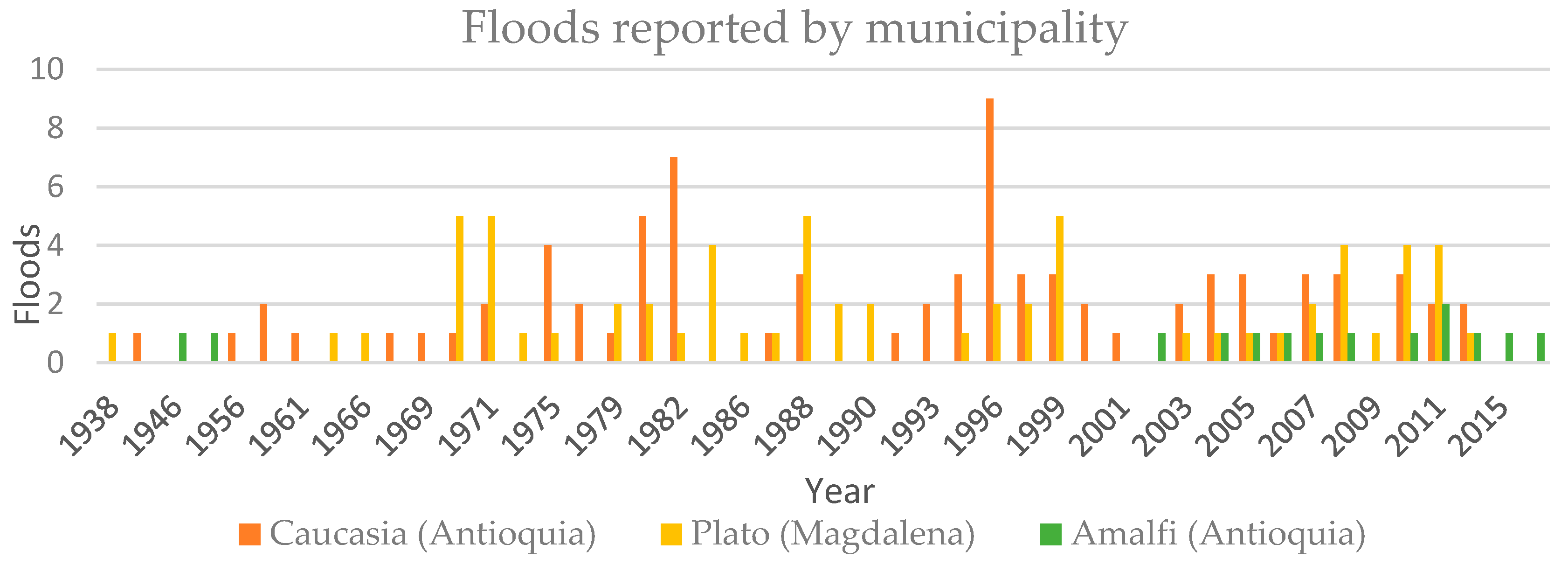Computational Bottom-Up Vulnerability Indicator for Low-Income Flood-Prone Urban Areas
Abstract
1. Introduction
2. Materials and Methods
2.1. Municipalities, Case Studies
2.1.1. Amalfi, Antioquia
2.1.2. Plato, Magdalena
2.1.3. Caucasia, Antioquia
2.2. Data Collection
2.3. Multiple Correspondence Analysis
3. Results
3.1. Slow-Onset Flood: Plato and Caucasia
3.2. Sudden Floods: Amalfi
4. Discussion and Conclusions
Author Contributions
Funding
Acknowledgments
Conflicts of Interest
References
- Salas, M.A.; Jiménez, M. Inundaciones; Versión el Centro Nacional de Prevención de Desastres-CENAPRED: México, Mexico, 2013; ISBN 970-628-870-8. [Google Scholar]
- United Nations Organization. Naciones Unidas Rio+20 El Futuro que Queremos. Available online: https://www.un.org/es/sustainablefuture/disasters.shtml (accessed on 13 June 2019).
- Jha, A.K.; Bloch, R.; Lamond, J. Cities and Flooding. A Guide to Integrated Urban Flood Risk Management for 21st Century; World Bank: Washington, DC, USA, 2012; ISBN 978-08213-8866-2. [Google Scholar]
- Centre for Research on the Epidemiology of Disasters-CRED. EM-DAT: The OFDA/CRED International Disaster Database. Available online: http://www.emdat.be/database (accessed on 13 June 2019).
- Hoyois, P.; Guha-sapir, D. Three Decades of Floods in Europe: A preliminary Analysis of EMDAT Data; WHO collaborating centre for research on the epidemiology of disasters (CRED); Catholique University of Louvain: Louvain, Belgium, 2003; pp. 1–15. [Google Scholar]
- World Health Organization WHO|Flooding and Communicable Diseases Fact Sheet; World Health Organization: Geneva, Switzerland, 2012.
- Jakubicka, T.; Vos, F.; Phalkey, R.; Marx, M. Health Impacts of Floods in Europe; Centre for Research on the Epidemiology of Disasters—CRED: Brussels, Belgium, 2010. [Google Scholar]
- UN Office for Disaster Risk Reduction. Sendai Framework for Disaster Risk Reduction 2015–2030; UN Nations Office for Disaster Risk Reduction: Geneva, Switzerland, 2015. [Google Scholar]
- Revi, A.; Satterthwaite, D.E.; Aragón-Durand, F.; Corfee-Morlot, J.; Kiunsi, R.B.R.; Pelling, M.; Roberts, D.C.; Solecki, W. Urban Areas. In Climate Change 2014: Impacts, Adaptation, and Vulnerability. Part A: Global and Sectoral Aspects; Contribution of Working Group II to the Fifth Assessment Report of the Intergovernmental Panel on Climate Change; Cambridge University Press: Cambridge, UK; New York, NY, USA, 2014; pp. 535–612. [Google Scholar]
- Panel Intergubernamental de Cambio Climático—IPCC. Managing the Risks of Extreme Events and Disasters to Advance Climate Change Adaptation; Field, C.B., Barros, V., Stocker, T.F., Dahe, Q., Eds.; Cambridge University Press: Cambridge, UK, 2012; ISBN 9781139177245. [Google Scholar]
- Perles Roselló, M.J.; Sortino Barrionuevo, J.F.; Cantarero Prados, F. Cartografía de la vulnerabilidad del territorio frente al riesgo de inundación. Propuesta adaptada a la directiva europea de inundaciones y normativas derivadas. Boletín Asoc. Geógrafos Españoles 2017, 75, 341–372. [Google Scholar] [CrossRef][Green Version]
- Gouldby, B.; Samuels, P.; Klijn, F.; Messner, F.; Ad Van, O.; Sayers, P. Language of Risk; HR Wallingford: Wallingford, UK, 2005. [Google Scholar]
- Congreso de la República de Colombia. Ley 1523 de 2012. Por la Cual se Adopta la Política Nacional de Gestión del Riesgo de Desastres y se Dictan Otras Disposiciones; Congreso de la República de Colombia: Bogotá, Colombia, 2012; p. 16. [Google Scholar]
- Adger, W.; Brooks, N.; Bentham, G.; Agnew, M. New Indicators of Vulnerability and Adaptive Capacity; Tyndall Centre Technical Report 7; Tyndall Centre for Climate Change Research: Norwich, UK, 2004. [Google Scholar]
- Bankoff, G. Constructing vulnerability: The historical, natural and social generation of flooding in metropolitan Manila. Disasters 2003, 27, 224–238. [Google Scholar] [CrossRef] [PubMed]
- Damm, M. Mapping Social-ecological Vulnerability to Flooding. Ph. D. Thesis, United Nations University, Tokyo, Japan, 2010. [Google Scholar]
- Fekete, A. Assessment of Social Vulnerability to River Floods in Germany. Ph. D. Thesis, United Nations University, Tokyo, Japan, 2010. [Google Scholar]
- García, C.E.; Hurtado, J.E. Modelo Basado en Lógica Difusa para la Construcción Indicadores Vulnerabilidad Frente de Indicador es de V ulnerabilidad Urbana Fr ente a Fenómenos Naturales. Gestión Ambient. 2003, 6, 1–22. [Google Scholar]
- Kuhlicke, C.; Scolobig, A.; Tapsell, S.; Steinführer, A.; Marchi, B. Contextualizing social vulnerability: Findings from case studies across Europe. Nat. Hazards 2011, 58, 789–810. [Google Scholar] [CrossRef]
- Cutter, S.L.; Boruff, B.J.; Shirley, W.L. Social vulnerability to environmental hazards. Soc. Sci. Q. 2003, 84, 242–261. [Google Scholar] [CrossRef]
- Blaikie, P.; Cannon, T.; Davis, I.; Wisner, B. Vulnerabilidad. El Entorno Social, Político y Económico de los Desastres; LA RED/ITDG: Bogotá, Colombia, 1996. [Google Scholar]
- Turner, B.L.; Kasperson, R.E.; Matsone, P.A.; McCarthy, J.J.; Corell, R.W.; Christensene, L.; Eckley, N.; Kasperson, J.X.; Luers, A.; Martello, M.L.; et al. A framework for vulnerability analysis in sustainability science. Proc. Natl. Acad. Sci. USA 2003, 100, 8074–8079. [Google Scholar] [CrossRef] [PubMed]
- Cannon, T. Vulnerability analysis and disasters. Floods 2000, 1, 45–55. [Google Scholar]
- Cupples, J. Gender and Hurricane Mitch: Reconstructing subjectivities after disaster. Disasters 2007, 31, 155–175. [Google Scholar] [CrossRef]
- Kubal, C.; Haase, D.; Meyer, V.; Scheuer, S. Integrated urban flood risk assessment—Adapting a multicriteria approach to a city. Nat. Hazards Earth Syst. Sci. 2009, 9, 1881–1895. [Google Scholar] [CrossRef]
- Zhang, Y.; Lindell, M.K.; Prater, C.S. Vulnerability of community businesses to environmental disasters. Disasters 2009, 33, 38–57. [Google Scholar] [CrossRef]
- Birkmann, J. Measuring Vulnerability to Natural Hazards: Towards Disaster Resilient Societies; United Nations University: New York, NY, USA, 2006; ISBN 92-808-1135-5. [Google Scholar]
- Secretaría Interinstitucional de la Estrategia Internacional para la Reducción de Desastres. Vivir con el Riesgo. Informe Mundial Sobre Iniciativas para la Reducción de Desastres; Secretaría Interinstitucional de la Estrategia Internacional para la Reducción de Desastres: Geneva, Switzerland, 2004; ISBN 92-1-300228-9. [Google Scholar]
- Rodríguez-Gaviria, E.M. Diseño Metodológico Para La Evaluación Del Riesgo Por Inundación A Nivel Local Con Información Escasa; Universidad Nacional de Colombia-Sede Medellín: Medellín, Colombia, 2016. [Google Scholar]
- Cutter, S.L.; Ash, K.D.; Emrich, C.T. The geographies of community disaster resilience. Glob. Environ. Chang. 2014, 29, 65–77. [Google Scholar] [CrossRef]
- Intergovernmental Panel on Climate Change (IPCC). Climate Change: New Dimensions in Disaster Risk, Exposure, Vulnerability, and Resilience. In Managing the Risks of Extreme Events and Disasters to Advance Climate Change Adaptation: Special Report of the Intergovernmental Panel on Climate Change; Intergovernmental Panel on Climate Change (IPCC): Geneva, Switzerland, 2012; Volume 9781107025, pp. 25–64. ISBN 9781139177245. [Google Scholar]
- Apel, A.; Thieken, A.H.; Merz, B.; Blösch, G. Flood risk assessment and associated uncertainties. Nat. Hazards Earth Syst. Sci. 2004, 4, 295–308. [Google Scholar] [CrossRef]
- Villagrán de León, J.C. Vulnerability. A Conceptual and Methodological Review; United Nations University Institute for Environment and Human Security (UNU-EHS): Bonn, Germany, 2006; ISBN 3981058240. [Google Scholar]
- Federal Emergency Management Agency (FEMA). Technical Manual FLOOD MODEL; Federal Emergency Management Agency (FEMA): Washington, DC, USA, 2004. [Google Scholar]
- Fekete, A.; Lauwe, P.; Geier, W. Risk management goals and identification of critical infrastructures. Int. J. Crit. Infrastruct. 2012, 8, 336–353. [Google Scholar] [CrossRef]
- Zahran, S.; Brody, S.D.; Peacock, W.G.; Vedlitz, A.; Grover, H. Social vulnerability and the natural and built environment: A model of flood casualties in Texas. Disasters 2008, 32, 537–560. [Google Scholar] [CrossRef] [PubMed]
- Chingombe, W.; Pedzisai, E.; Manatsa, D.; Mukwada, G.; Taru, P. A participatory approach in GIS data collection for flood risk management, Muzarabani district, Zimbabwe. Arab. J. Geosci. 2014, 8, 1029–1040. [Google Scholar] [CrossRef]
- Kienberger, S. Participatory mapping of flood hazard risk in Munamicua, District of Búzi, Mozambique. J. Maps 2014, 10, 269–275. [Google Scholar] [CrossRef]
- Tran, P.; Shaw, R.; Chantry, G.; Norton, J. GIS and local knowledge in disaster management: a case study of flood risk mapping in Viet Nam. Disasters 2009, 33, 152–169. [Google Scholar] [CrossRef] [PubMed]
- White, I.; Kingston, R.; Barker, A. Participatory geographic information systems and public engagement within flood risk management. J. Flood Risk Manag. 2010, 3, 337–346. [Google Scholar] [CrossRef]
- Peters-Guarín, G.; McCall, M.K.; van Westen, C. Coping strategies and risk manageability: Using participatory geographical information systems to represent local knowledge. Disasters 2012, 36, 1–27. [Google Scholar] [CrossRef]
- Lu, S.; Mei, P.; Wang, J.; Zhang, H. Fatality and influence factors in high-casualty fires: A correspondence analysis. Saf. Sci. 2012, 50, 1019–1033. [Google Scholar] [CrossRef]
- Dodgson, J.S.; Spackman, M.; Pearman, A.; Phillips, L.D. Multi-Criteria Analysis: A Manual; Department for Communities and Local Government: London, UK, 2009; Volume 11, ISBN 9781409810230. [Google Scholar]
- Abdi, H.; Valentin, D. Multiple correspondence analysis. Encycl. Meas. Stat. 2007, 95, 116–128. [Google Scholar]
- Conte, J.C.; Rubio, E.; García, A.I.; Cano, F. Occupational accidents model based on risk–injury affinity groups. Saf. Sci. 2011, 49, 306–314. [Google Scholar] [CrossRef]
- Abad, J.; Blanco, P.; García, A. Análisis de Correspondencias y estudio de historias de vida: Una aplicación a la Encuesta de Transición Educativo-Formativa e Inserción Laboral. Pecvnia 2008, 6, 1–27. [Google Scholar] [CrossRef][Green Version]
- Reis, A.P.; Patinha, C.; Ferreira da Silva, E.; Sousa, A.; Figueira, R.; Sérgio, C.; Novais, V. Assessment of human exposure to environmental heavy metals in soils and bryophytes of the central region of Portugal. Int. J. Environ. Health Res. 2010, 20, 87–113. [Google Scholar] [CrossRef] [PubMed]
- United Nations Department of Economic and Social Affairs (UN/DESA); United Nations Conference on Trade and Development (UNCTAD); Economic Commission for Africa (ECA); Economic Commission for Europe (ECE); Economic Commission for Latin America and the Caribbean (ECLAC); Economic and Social Commission for Asia and the Pacific (ESCAP); Economic and Social Commission for Western Asia (ESCWA); The United Nations World Tourism Organization (UNWTO). World Economic Situation and Prospects 2018; United Nations Publication: New York, NY, USA, 2018; ISBN 9789211091779. [Google Scholar]
- Congreso de la República de Colombia. Ley 617 de 2000; Congreso de la República de Colombia: Bogotá, Colombia, 2000; p. 280. [Google Scholar]
- Contaduría General de la Nación. Categorización Municipios y Departamentos; Contaduría General de la Nación: Bogotá, Colombia, 2018. [Google Scholar]
- Brakenridge, R. Global Active Archive of Large Flood Events. Available online: http://floodobservatory.colorado.edu/Archives/ (accessed on 1 october 2015).
- Guha-Sapir, D.; Vos, F.; Below, R. Annual Disaster Statistical Review 2011-The Numbers and Trends; Centre for Research on the Epidemiology of Disasters (CRED), Centre for Research on the Epidemiology of Disasters (CRED), Université Catholique de Louvain: Brussels, Belgium, 2012. [Google Scholar]
- Congreso de Colombia. Ley 1523 de 2012; Congreso de Colombia: Bogotá, Colombia, 2012; p. 30. [Google Scholar]
- Ministerio de Vivienda Sociedad y Territorio. Decreto 1807 de 2014 en lo Relativo a la Incorporación de la Gestión del Riesgo en los Planes de Ordenamiento; Ministerio de Vivienda Sociedad y Territorio: Bogotá, Colombia, 2014. [Google Scholar]
- Instituto de Hidrología y Metereología y Estudios Ambientales-IDEAM. Clasificaciones Climáticas de Colombia. Available online: http://www.ideam.gov.co/documents/21021/21789/climas+%5BModo+de+compatibilidad%5D.pdf/d8c85704-a07a-4290-ba65-f2042ce99ff9 (accessed on 5 August 2019).
- Kottek, M.; Grieser, J.; Beck, C.; Rudolf, B.; Rubel, F. World map of the Köppen-Geiger climate classification updated. Meteorol. Z. 2006, 15, 259–263. [Google Scholar] [CrossRef]
- Institución Universitaria Colegio Mayor de Antioquia; Universidad Nacional de Colombia; Municipio de Amalfi. Propuesta Metodológica Para Evaluar El Riesgo Por Inundaciones Súbitas De La Quebrada Tequendamita (Amalfi, Antioquia); Colegio Mayor de Antioquia: Amalfi, Colombia, 2018. [Google Scholar]
- Estadística, D.A. Necesidades Básicas Insatisfechas (NBI) por Municipio. Available online: http://www.dane.gov.co/index.php/estadisticas-por-tema/pobreza-y-condiciones-de-vida/necesidades-basicas-insatisfechas-nbi (accessed on 14 June 2019).
- De Bruijn, K.; de Frans, K.; Ölfert, A.; Penning-Rowsell, E.; Simm, J.; Wallis, M. Flood Risk Assessment and Flood Risk Management; HR Wallingford: Wallingford, UK, 2009. [Google Scholar]
- Instituto de Hidrología y Metereología y Estudios Ambientales-IDEAM. Inundaciones. Available online: http://www.ideam.gov.co/web/agua/amenazas-inundacion (accessed on 15 May 2019).
- Unidad Nacional de Gestión del Riesgo Inundaciones. Available online: http://www.sigpad.gov.co/sigpad/paginas_detalle.aspx?idp=144 (accessed on 17 February 2019).
- Universidad Nacional de Colombia. Criterios Metodológicos Mínimos Para La Elaboración E Interpretación Cartográfica De Zonificaciones De Amenaza Por Inundaciones Fluviales Para El Territorio Colombiano Con Una Aplicación Práctica De Dos Áreas Piloto (Inundaciones Lentas Y Súbitas) Fase I.; Universidad Nacional de Colombia: Medellín, Colombia, 2010. [Google Scholar]
- Corporación OSSO. Base de Datos DAPARD, Colombia—Inventario de Desastres Antioquia; Corporación OSSO: Cali, Colombia, 2015. [Google Scholar]
- Unidad Nacional de Gestión del Riesgo. Reporte de Emergencias; Unidad Nacional de Gestión del Riesgo: Bogotá, Colombia, 2015. [Google Scholar]
- NOAA Center for Weather and Climate Prediction. Historical El Niño/La Niña Episodes (1950-Present). Available online: http://www.cpc.ncep.noaa.gov/products/analysis_monitoring/ensostuff/ensoyears.shtml (accessed on 9 July 2015).
- Berariu, R.; Fikar, C.; Gronalt, M.; Hirsch, P. Understanding the impact of cascade effects of natural disasters on disaster relief operations. Int. J. Disaster Risk Reduct. 2015, 12, 350–356. [Google Scholar] [CrossRef]
- Alcaldía Municipal de Amalfi. Plan de Desarrollo Municipal Amalfi Antioquia 2016–2019 “Amalfi, Amor y Pasión de Todos”; Alcaldía Municipal de Amalfi: Amalfi, Colombia, 2016. [Google Scholar]
- Alcaldía de Plato. Plan de Desarrollo Plato 2016–2019; Alcaldía de Plato: Plato, Colombia, 2016. [Google Scholar]
- Alcaldía de Caucasia. Plan de Desarrollo Caucasia 2016–2019; Alcaldía de Caucasia: Caucasia, Colombia, 2017. [Google Scholar]
- Botero, V. Geo-Information for Measuring Vulnerability to Earthquakes: A Fitness for Use Approach; University of Utrecht: Utrecht, The Netherlands, 2009. [Google Scholar]
- Martínez, J. The use of GIS and indicators to monitor intra-urban inequalities. A case study in Rosario, Argentina. Habitat Int. 2009, 33, 387–396. [Google Scholar] [CrossRef]
- Hartung, C.; Lerer, A.; Anokwa, Y.; Tseng, C.B.W. Open data kit: Tools to build information services for developing regions. In Proceedings of the 4th International Conference on Information and Communication Technologies and Development, London, UK, 13–16 December 2010. [Google Scholar]
- Buckle, P.; Mars, G.; Smale, R.S. New approaches to assessing vulnerability and resilience. Aust. J. Emerg. Manag. 2000, 15, 8–14. [Google Scholar]
- Thouret, J.C.; Ettinger, S.; Guitton, M.; Santoni, O.; Magill, C.; Martelli, K.; Zuccaro, G.; Revilla, V.; Charca, J.A.; Arguedas, A. Assessing physical vulnerability in large cities exposed to flash floods and debris flows: The case of Arequipa (Peru). Nat. Hazards 2014, 73, 1771–1815. [Google Scholar] [CrossRef]
- Universidad de Washington, Department of Computer Science and Engineering. Open Data Kit—ODK; Universidad de Washington, Department of Computer Science and Engineering: Washington, DC, USA, 2015. [Google Scholar]
- Caceres, A.; Basagaña, X.; Gonzalez, J.R. Multiple correspondence discriminant analysis: An application to detect stratification in copy number variation. Stat. Med. 2010, 29, 3284–3293. [Google Scholar] [CrossRef]
- Pinti, A.; Rambaud, F.; Griffon, J.-L.; Ahmed, A.T. A tool developed in Matlab for multiple correspondence analysis of fuzzy coded data sets: Application to morphometric skull data. Comput. Methods Programs Biomed. 2010, 98, 66–75. [Google Scholar] [CrossRef] [PubMed]
- Greenacre, M. Correspondence analysis of raw data. Ecology 2010, 91, 958–963. [Google Scholar] [CrossRef] [PubMed]
- Batista-Foguet, J.M.; Revilla, M.; Saris, W.E.; Boyatzis, R.; Serlavós, R. Reassessing the Effect of Survey Characteristics on Common Method Bias in Emotional and Social Intelligence Competencies Assessment. Struct. Equ. Model. 2014, 21, 596–607. [Google Scholar] [CrossRef]
- Husson, F.; Lê, S.; Mazet, J. Factor Analysis and Data Mining with R. 2006. Available online: http://ftp.auckland.ac.nz/software/CRAN/doc/packages/FactoMineR.pdf (accessed on 10 August 2019).
- R Core Team. R: A language and environment for statistical computing. Available online: http://www.r-project.org/ (accessed on 29 May 2019).
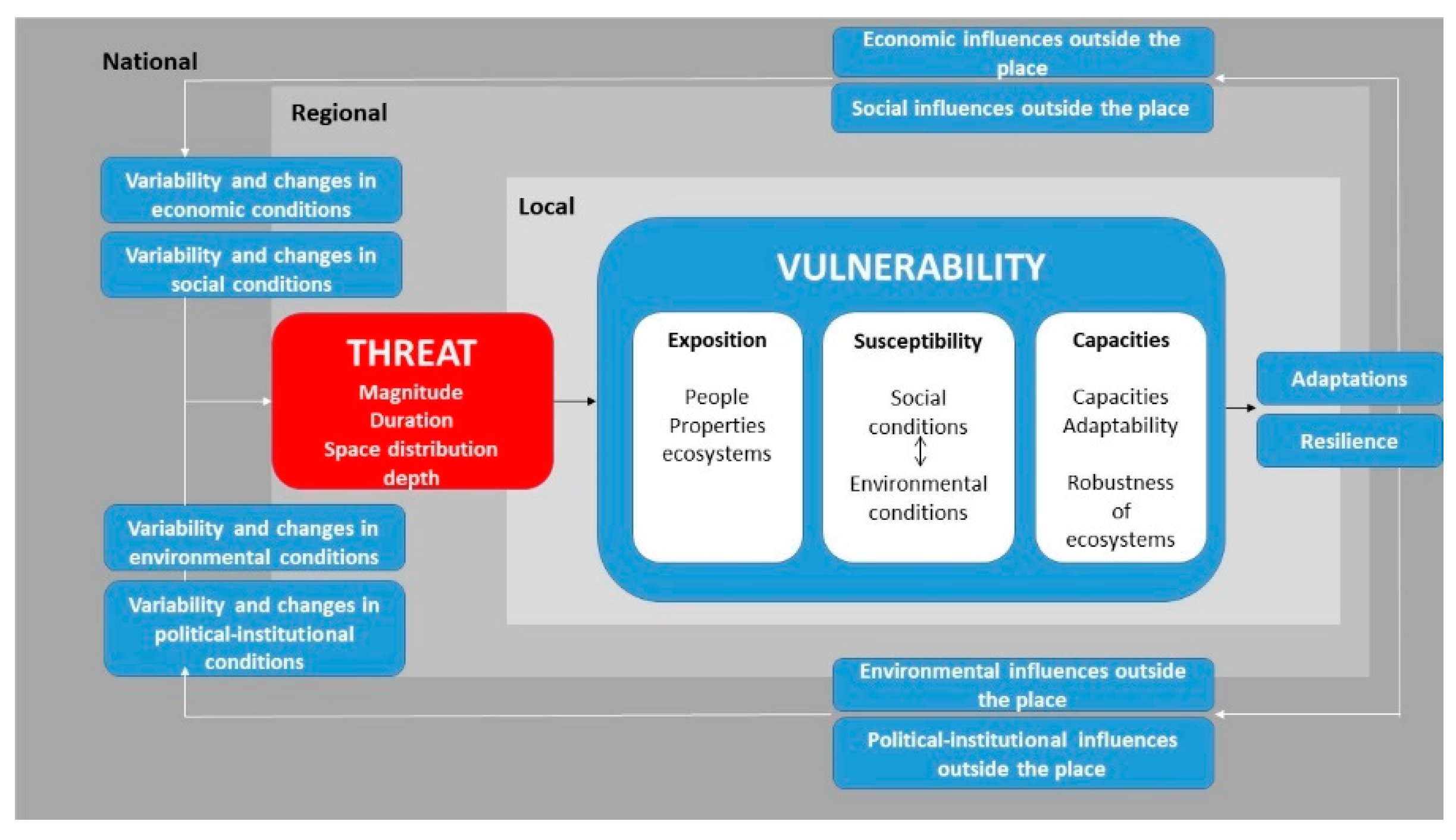
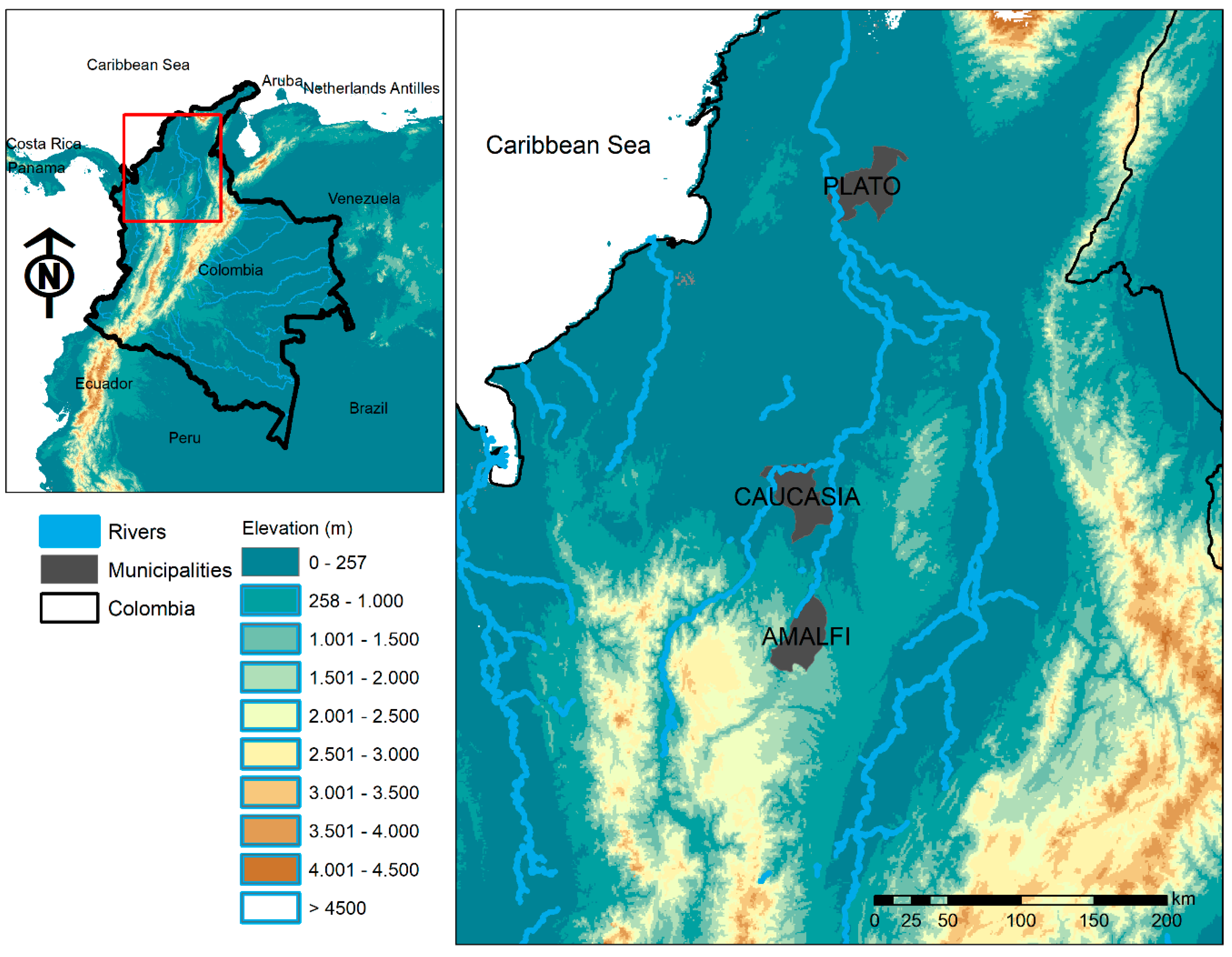
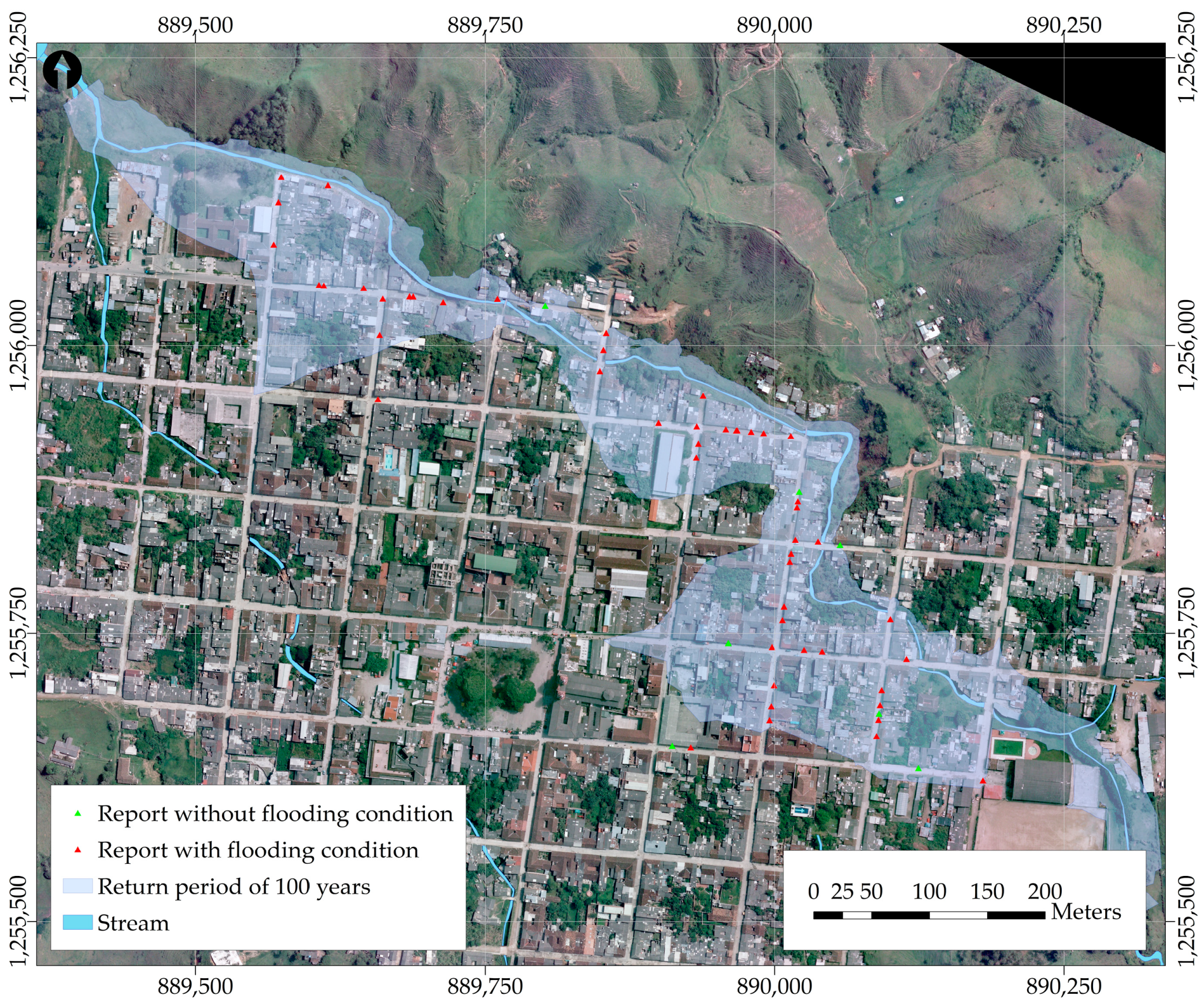
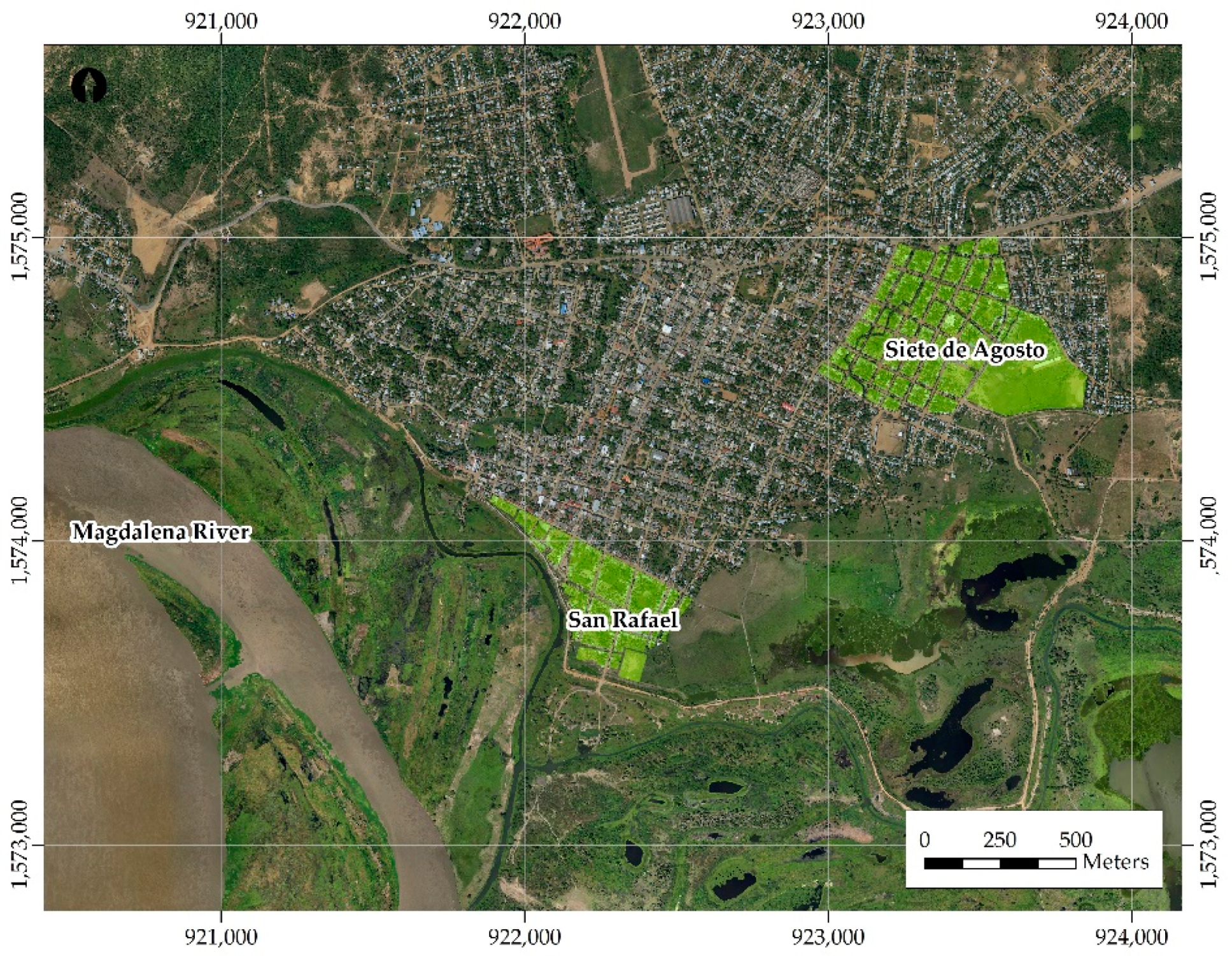

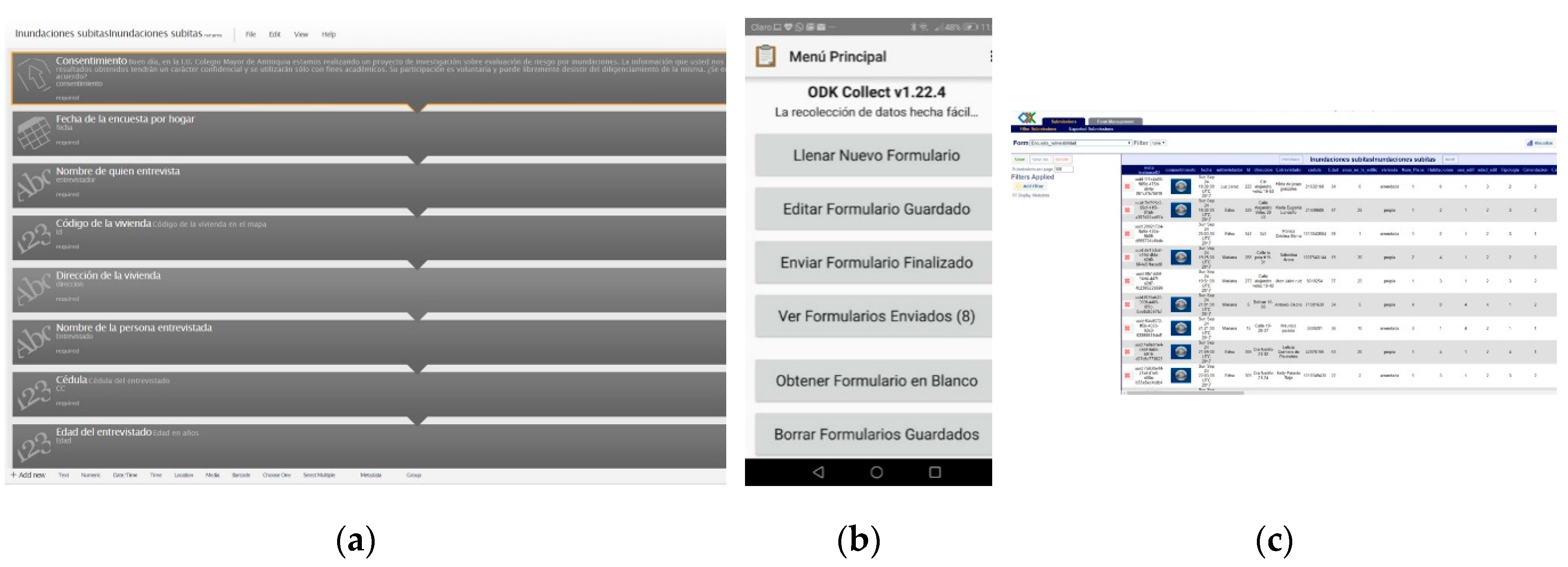
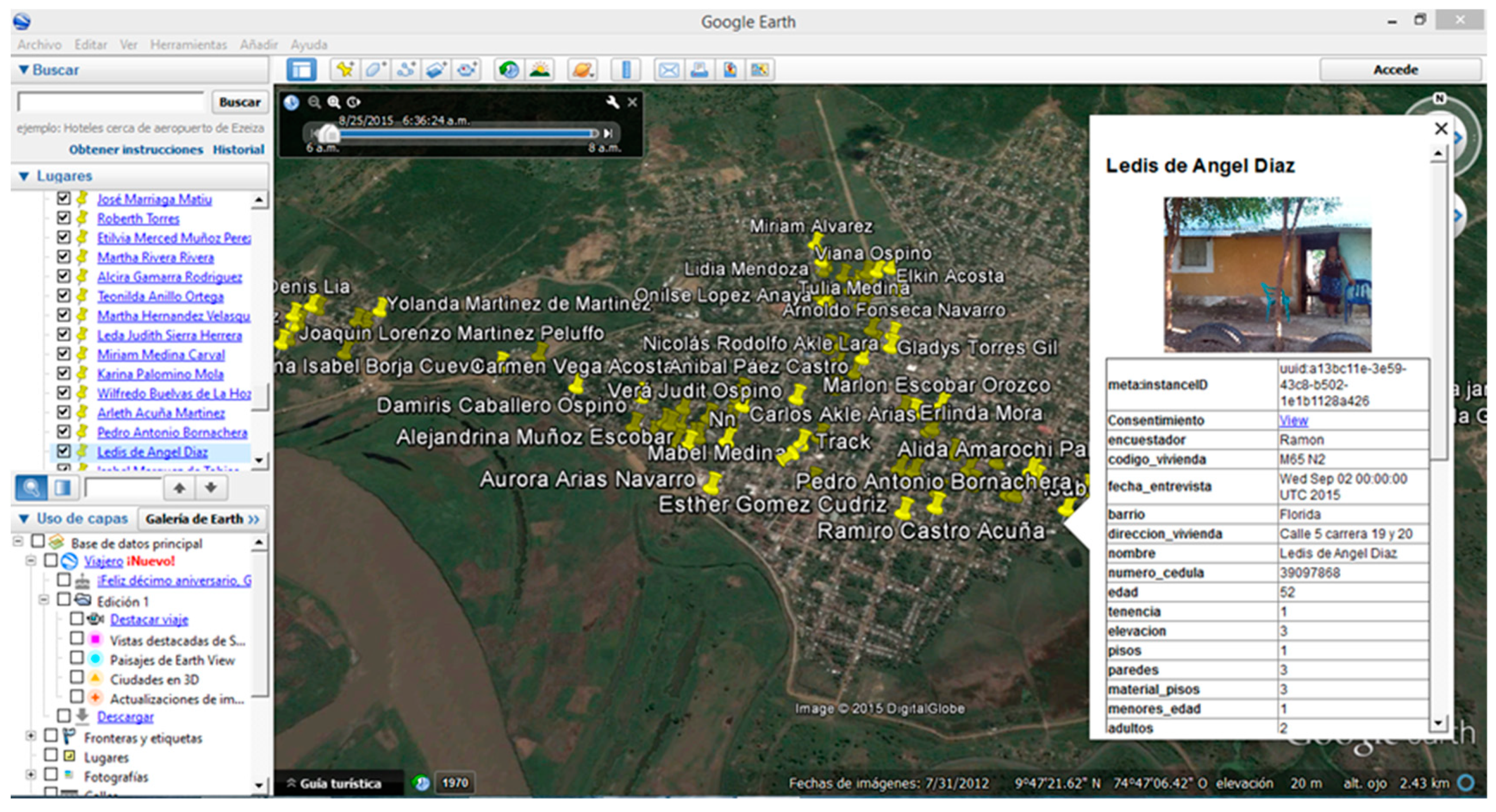

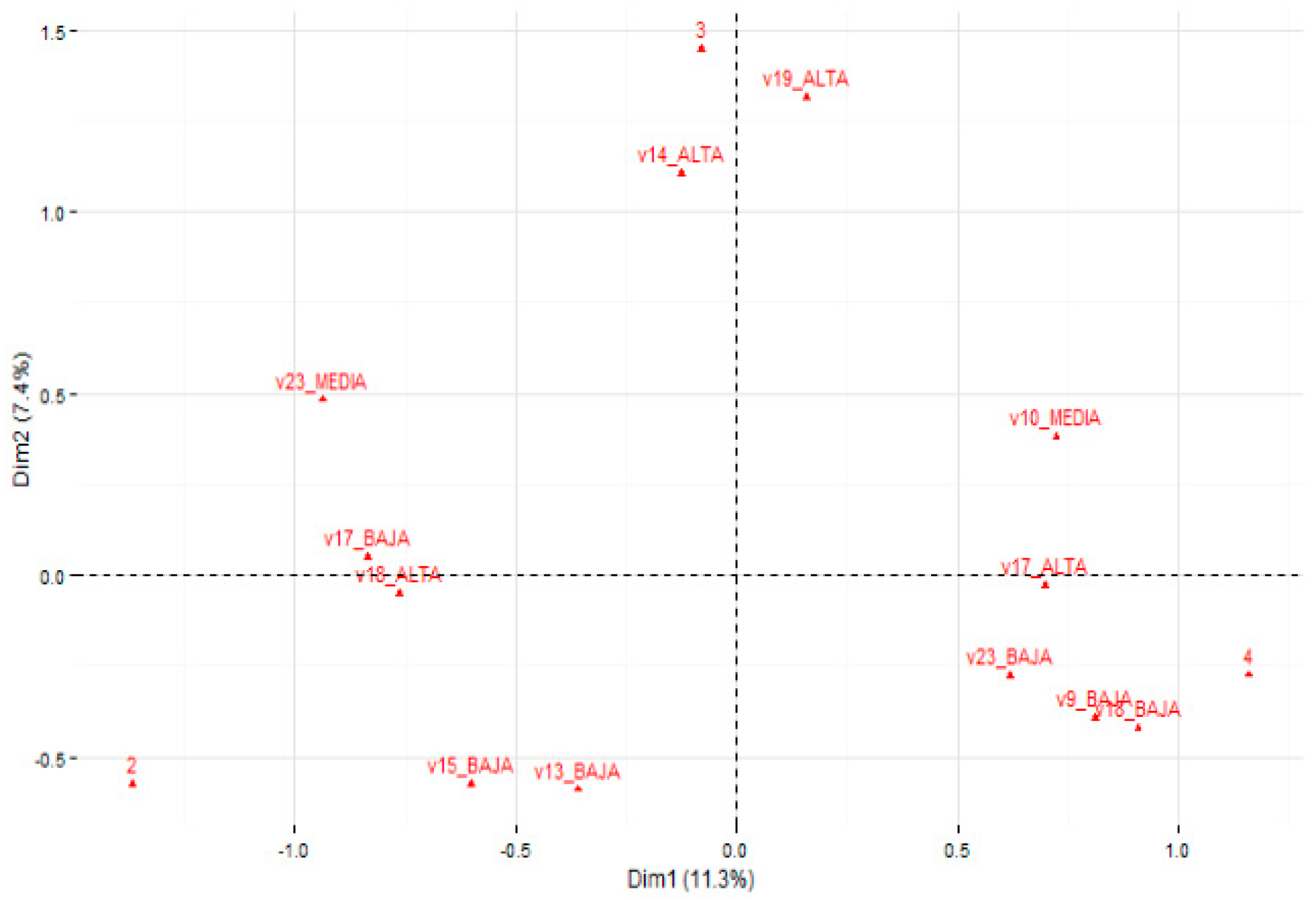
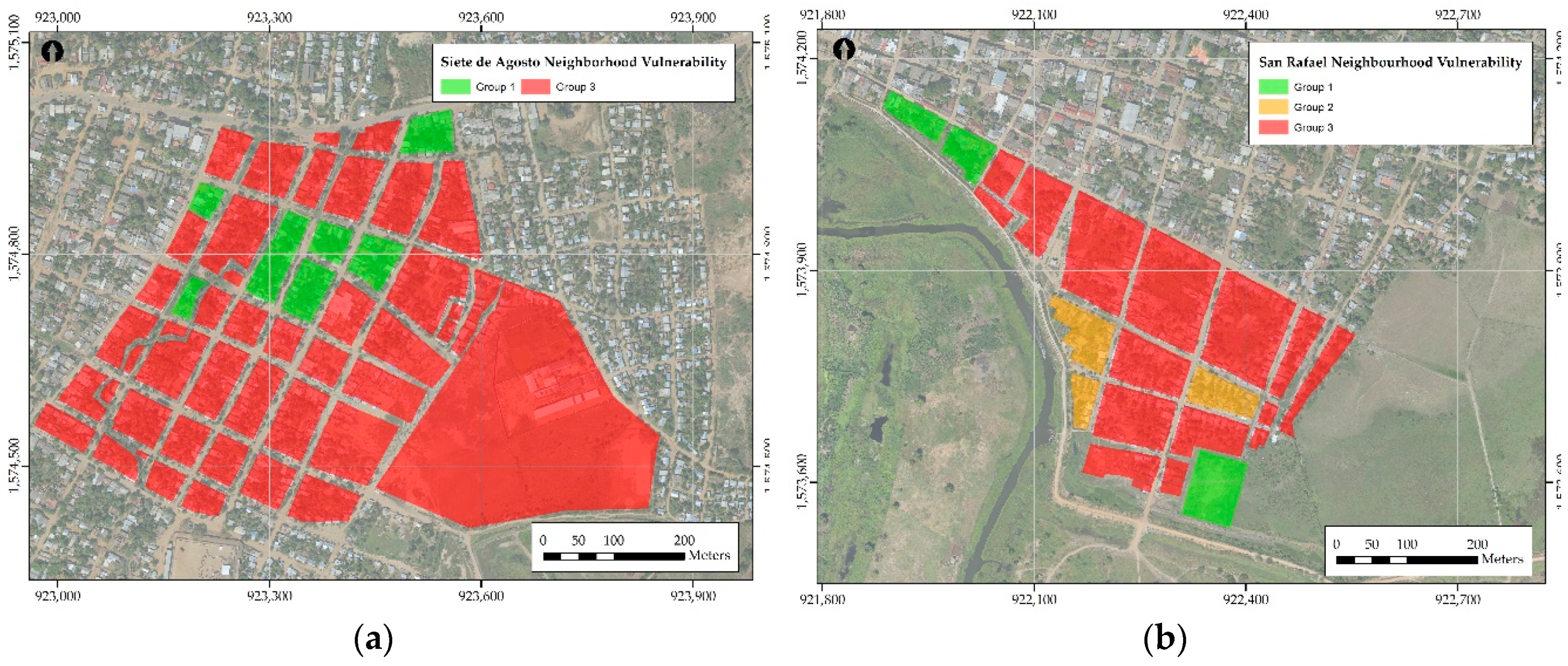

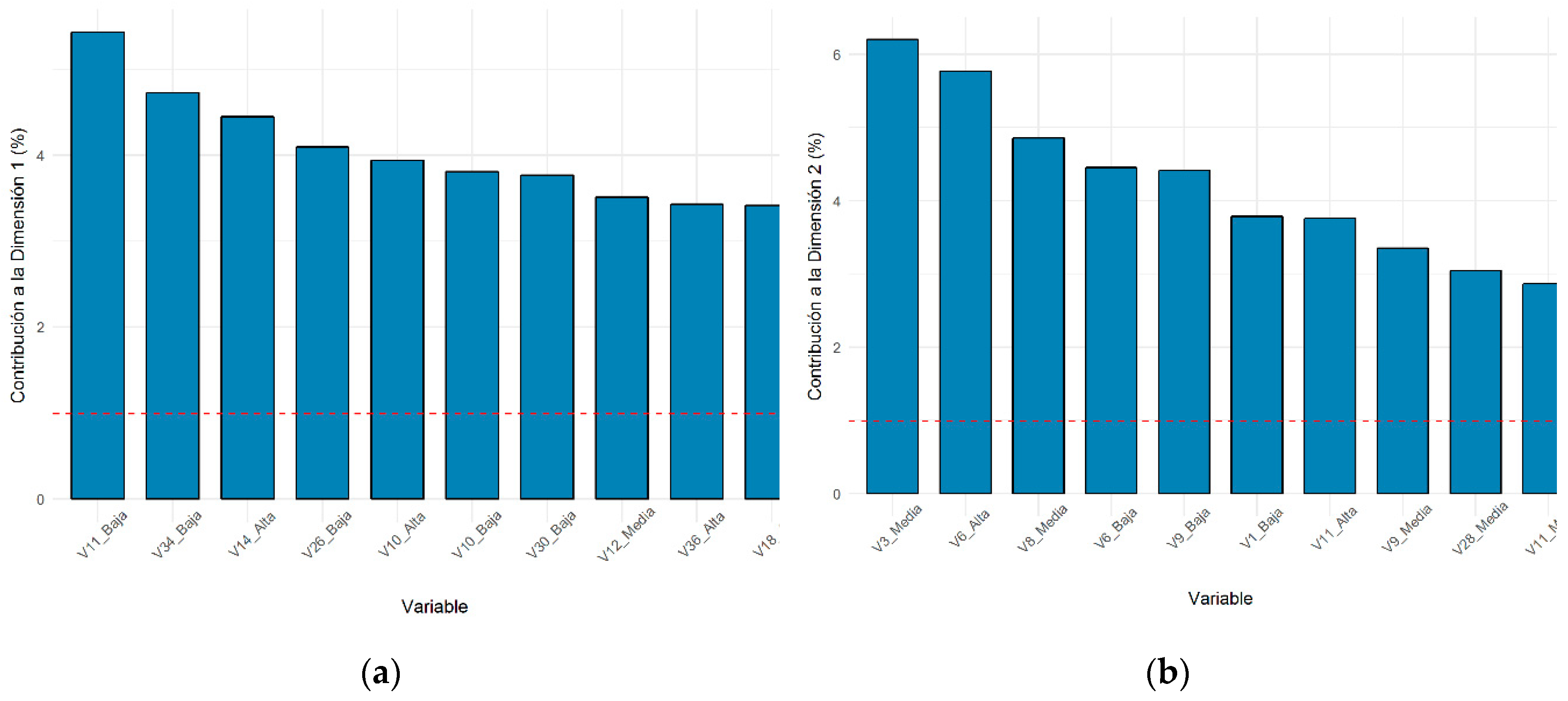
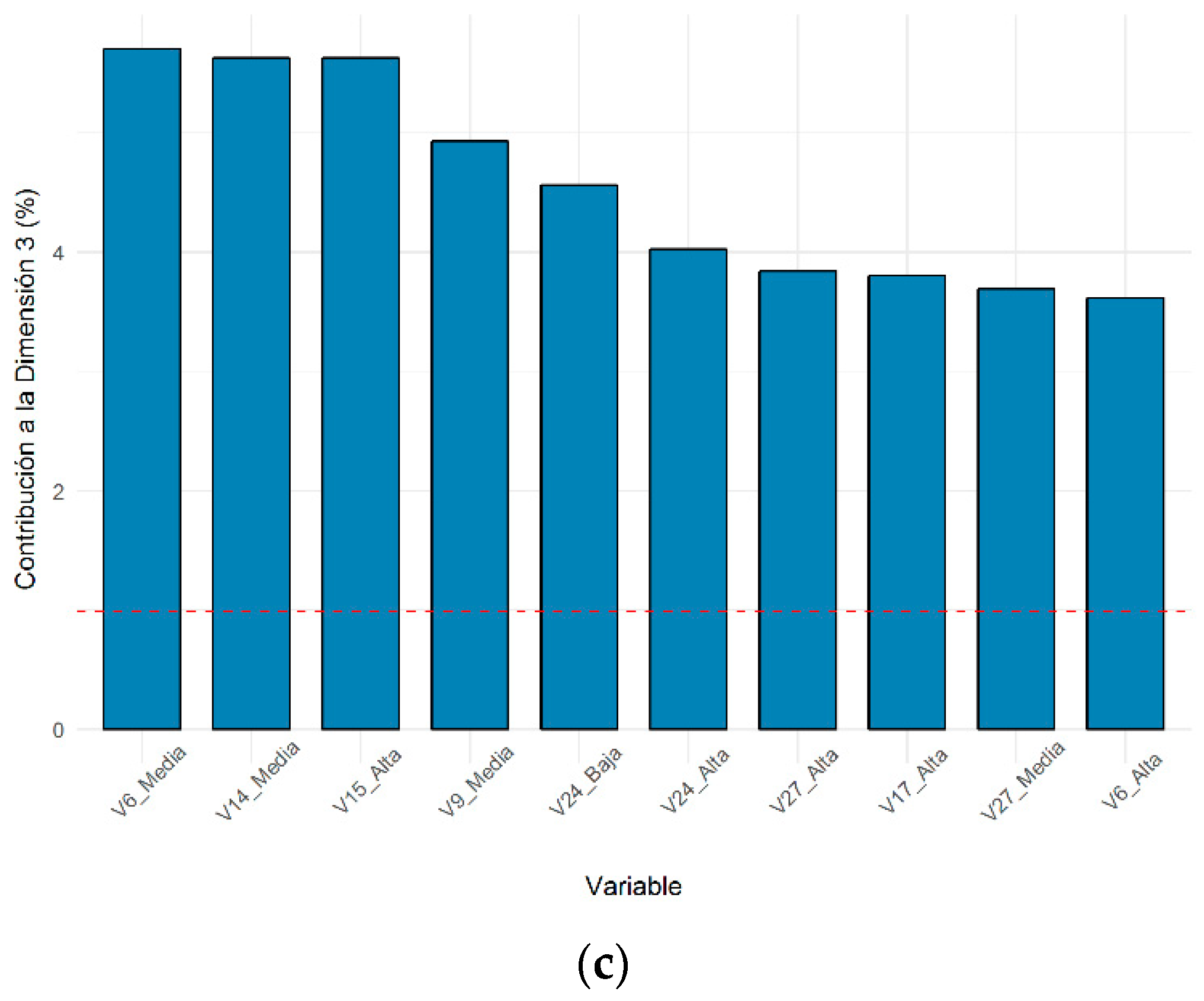

| Vulnerability | ||
|---|---|---|
| Exposure | Susceptibility | Resilience |
| People with permanent disabilities | Evacuation procedures | Educational level reached of the inhabitants of the home |
| Household inhabitants’ gender | Access to public services | Participation in associative organizations |
| Age of the inhabitants of the household | Impact on the provision of public services | Access to health services |
| Family structure | Employment level—Labor situation | Housing availability after evacuations during floods (R) |
| Overcrowding | Income per household | Access to warning systems |
| Angle of the building with respect to the river channel | Economically dependent household members | Access to humanitarian aid |
| Household height with respect to the base level of the river channel | Family debts | Access to media |
| Protective elements | Loss of housing contents | Acceptance and result of the processes of prevention, attention, and education against risk |
| Number of windows and doors on the most exposed façade | Investment on home repairs to avoid damage and losses due to floods | Trust in the government institutions response in case of an event. |
| Typology of the building—Material of walls and floors | Population density per block and homes | Awareness of the relationship between environmental management and risk reduction |
| Distance to the nearest drainage or river | State of preservation of the structure | Awareness of the ability of institutions to react to a risk situation |
| Building area | Year of construction of the building | Self-awareness of being under risk |
| Construction density of the block | House tenure | |
| Loss of flood energy considering block form | Existence of insurance culture and savings among the inhabitants of the municipality | |
| Road density per block | ||
| Type of structural foundation | ||
| Variable | Typology of the Building—Material of Walls and Floors | ||
|---|---|---|---|
| Possible outcomes of the variable | Block, brick, stone, polished wood, stepped wall and adobe. | Bahareque, prefabricated material, rough wood, board, plank. | Guadua, cane, mat, other vegetable, zinc, cloth, cardboard, cans, waste, plastics. |
| Qualification (qualitative) | Low (L) | Medium (M) | High (H) |
| Qualification (quantitative) | (0.2) | (0.3) | (0.5) |
| Vi | Vi+1 | Vi+2 | …….. | Vn | |
|---|---|---|---|---|---|
| Household 1 | M | H | M | H | |
| Household 2 | L | L | M | L | |
| ... | |||||
| Household n | H | H | M | H |
© 2019 by the authors. Licensee MDPI, Basel, Switzerland. This article is an open access article distributed under the terms and conditions of the Creative Commons Attribution (CC BY) license (http://creativecommons.org/licenses/by/4.0/).
Share and Cite
Rodríguez-Gaviria, E.M.; Ochoa-Osorio, S.; Builes-Jaramillo, A.; Botero-Fernández, V. Computational Bottom-Up Vulnerability Indicator for Low-Income Flood-Prone Urban Areas. Sustainability 2019, 11, 4341. https://doi.org/10.3390/su11164341
Rodríguez-Gaviria EM, Ochoa-Osorio S, Builes-Jaramillo A, Botero-Fernández V. Computational Bottom-Up Vulnerability Indicator for Low-Income Flood-Prone Urban Areas. Sustainability. 2019; 11(16):4341. https://doi.org/10.3390/su11164341
Chicago/Turabian StyleRodríguez-Gaviria, Edna M., Sol Ochoa-Osorio, Alejandro Builes-Jaramillo, and Verónica Botero-Fernández. 2019. "Computational Bottom-Up Vulnerability Indicator for Low-Income Flood-Prone Urban Areas" Sustainability 11, no. 16: 4341. https://doi.org/10.3390/su11164341
APA StyleRodríguez-Gaviria, E. M., Ochoa-Osorio, S., Builes-Jaramillo, A., & Botero-Fernández, V. (2019). Computational Bottom-Up Vulnerability Indicator for Low-Income Flood-Prone Urban Areas. Sustainability, 11(16), 4341. https://doi.org/10.3390/su11164341




